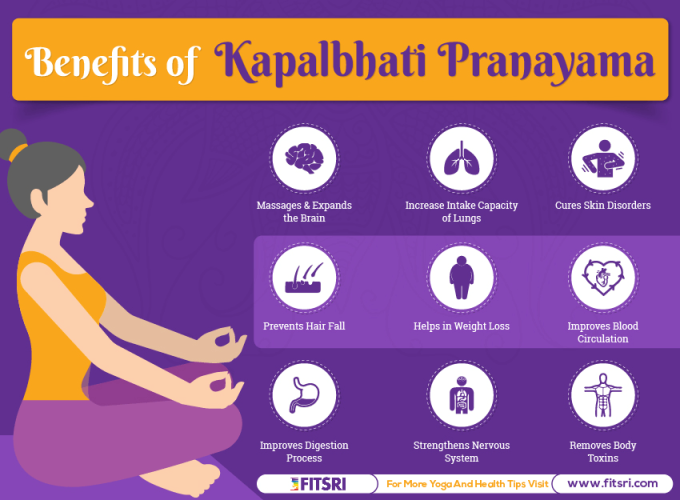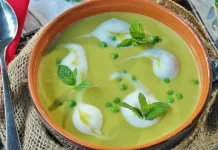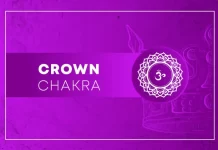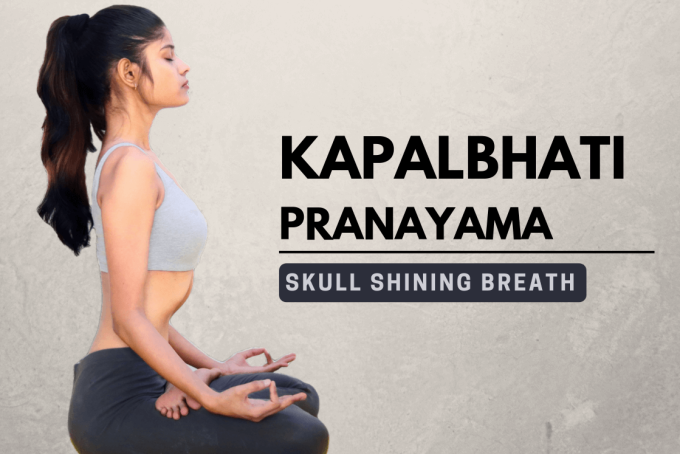Kapalbhati Pranayama do you know what makes Kapalbhati the most popular yoga breathing technique? It is the capacity to cleanse the body.
An advanced yogic breathing method that has several advantages is Kapalabhati pranayama breathing. Start with Ujjayi Pranayama if you haven’t before, and if you’re comfortable with it, switch to Kapalabhati breathing.
A typical person exhales 100 ml more carbon dioxide (CO2) during each Kapalbhati stroke than they would otherwise. This indicates that more poisons are expelled through the exhalation.
A beautiful breathing method called Kapalbhati Pranayama uses strong, quick exhalations followed by brief, passive inhalations. The next inhalation occurs naturally as a result of the lungs being empty.
This method of forceful exhale aids in stress reduction, enhances cognitive function, and enhances respiratory health. Additionally, it helps digestion and strengthens the abdominal muscles.
The advantages of Kapalbhati Pranayama will be discussed in more detail in this article, along with step-by-step instructions on how to perform it.
Kapalahbhati Pranayama also referred to as “skull-shining breath,” is derived from the Sanskrit terms Kapala, which means “skull,” and Bhati, which means “light.” It is a form of exercise that revitalizes, cleanses, and energizes both the body and the mind. This breath’s name comes from picturing your cranium overflowing with a dazzling light when you practice it.
This purifying breath can assist you in releasing stress and toxins from your body and mind as well as in letting go of unpleasant emotions, getting rid of lethargy, and feeling more energized. The instructions are at the conclusion of this article. It entails a sequence of strong exhalations followed by quiet inhalations.
Health Benefits
So, as you must already be aware, pranayama refers to a group of traditional breath-control techniques. This is frequently done in conjunction with yoga postures. Yoga asanas focus on stretching your body and physical structure, whilst pranayama aims to fill the newly formed space with healthy breath and uplifting energies.
Pranayama is a combination of the words Ayama, which indicates expansion, and prana, which means “life power.” In essence, pranayama is an extension of your life energy. This custom originated with Hinduism, perhaps even earlier (483 BC). Despite the fact that it has no religious overtones and is open to everyone,
What is Kapalbhati Pranayama?
Kapalbhati Pranayama is a basic breathing technique of yoga (Pranayama). It comprises short, powerful exhales and gentle inhales in synch with abdominal movement. As you inhale deeply through both nostrils, expand the chest and abdomen. While exhaling, rapidly draw the abdomen back and expel the air out. Exhale will automatically be followed by a short inhale and then exhale as previously.
However today it’s practiced as pranayama, in the ancient yogic text Hatha Yoga Pradipika, Kapalbhati is mentioned as one of the “shat kriya” or “six cleansing techniques” of yoga.
Kapalbhati Pranayama is essentially a brain-cleansing exercise for the frontal lobes. Additionally, it increases the effectiveness of the respiratory system and clears the nasal channel.
During Kapalbhati, you inhale quietly and exhale violently as opposed to the active and passive breathing patterns of regular breathing. The emphasis of this pranayama is on the exhale, which calls for tightening your abdominal muscles.
Kapalbhati means “Skull Shinning”
Kapalbhati means “shining skull” in Sanskrit. Kapal means “cranium or frontal head” and Bhati means “Shinning” in the Sanskrit phrase Kapalbhati.
It has been observed that Kapalbhati practitioners’ foreheads and skin begin to shine and that their frontal brain function improves.
After a few repetitions of practicing it, you’ll start to feel your head becoming lighter and your skull fills with light. They refer to it as “skull shining breath” or Kapalbhati pranayama for this reason.
The breath of fire pranayama is another name for Kapalbhati. Kapalbhati exhalation strokes that are quick and strong cause the body to become quite warm within.
Through sweating and the release of CO2, this heat helps the body rid itself of toxins and other waste products. Additionally, internal heat improves digestion and makes the skin and forehead shine.
Benefits of Kapalbhati Pranayama

You get a lot of physical and mental benefits from the Kapalbhati Pranayama. You strengthen your respiratory system. Additionally, the abdominal muscles’ active engagement strengthens and stimulates the digestive system.
Kapalbhati helps the brain receive more oxygen and blood, which helps with attention, concentration, and mental clarity.
These are merely a few advantages of regular practice; there are others, including the following:
- Kapalbhati exercises improve lung capacity and respiratory muscles.
- Kapalbhati clears the nadis. It encourages detoxification which paves way for healthy and glowing skin.
- By boosting the oxygen flow to the head, Kapalbhati pranayama help to lessen hair loss and stimulate the scalp for hair growth.
- Kapalbhati is one of the Best pranayama techniques for weight loss. It enhances metabolic activity and helps to burn out belly fat.
- It treats typical digestive issues such as gas, ulcers, constipation, diarrhea, and stomach pain.
- Capalbhati successfully manages diabetes. It stimulates the pancreas, which aids in the insulin secretion process.
- It gives a diabetic person the strength to combat several illnesses, including Alzheimer’s disease, eye impairment, kidney damage, and heart difficulties.
- Your immune system will naturally help you battle diseases since Kapalbhati strengthens it.
- It is said to relax and soothe the mind, allowing you to let go of stress and tension.
- It encourages the release of endorphins, which will keep you content and upbeat.
- Kapalbhati is very beneficial for women since it controls menstruation and prevents menstrual cramps.
- Your brain can be energized by the Kapalbhati, which will enhance your focus and memory.
What the science says
The practice of Kapalbhati has been well investigated, and the available evidence points to a number of advantages.
A study conducted in 2018 at Banaras Hindu University, India looked into the effects of Kapalbhati on mental
health and respiratory functions. The volunteers were told to practice Kapalbhati for 8 weeks. The researchers found that Kapalbhati pranayama increases lung capacity and is effective in bringing change in respiratory rate, positive breath-holding, Vital Capacity, and mental health.
Another study tested the effects of Kapalbhati pranayama on the respiratory system. This study measures the Peak Expiratory Flow Rate (PEFR) of volunteers, which is a measurement of how fast a person can exhale.
Before and after the six weeks, the peak expiratory flow rate was recorded. It was observed that the subjects’ PERF significantly improved after 6 weeks of Kapalbhati practice. This demonstrates how practicing Kapalbhati pranayama regularly improves the functionality of your respiratory system and strengthens your lungs for breathing.
Research conducted in Mumbai, India-based institution found that Kapalbhati pranayama is effective in reducing the waist and hip circumference in overweight individuals.
For this study, 60 overweight resident doctors were recruited for 8 weeks of control-trial study. The doctors were given Kapalbhati sessions, Monday to Saturday (15 minutes) under the supervision of experts. Post 8 weeks, it was observed that there was a significant reduction in the waist and hip circumference. This study proves the effectiveness of Kapalbhati for weight loss.
Research has also proven that Kapalbhati help reduces the Body Mass Index (BMI) and body fat percentage.
As you can see, science has also backed the benefits of Kapalbhati pranayama through thorough research and evidence. Though there are many such pieces of research that are still going on, it is safe to say that practicing Kapalbhati pranayama will not go to waste.
How to Do Kapalbhati Pranayama

Kapalbhati is traditionally performed while seated in a yoga position. If, however, you find it uncomfortable to sit in a yoga pose, you can practice it while seated on a chair. Always do this on an empty stomach when practicing. Depending on your degree of experience and preferences, it can last anywhere from 5 to 20 minutes.
To practice Kapalbhati pranayama, take the following actions:
- Start Kapalbhati by sitting in a cross-legged yoga pose, preferably an ‘easy pose‘ or ‘lotus pose. Sit up tall and roll back your shoulders.
- Place your hands on your knees, palms facing upward. You can also make Gyan mudra with one hand and place another hand on your belly to feel it rise as you breathe.
- Now pay attention to your stomach. Inhale deeply through your nose, allowing your tummy to enlarge.
- Without hesitating, exhale vigorously through your nostrils while tightening your abdominal muscles as you finish your inhalation. Pull your navel closer to your spine to exhale. Draw as much as you can safely do without becoming anxious.
- A hissing sound caused by the effort used to evacuate from the nostrils should be audible as you exhale.
- Breath leaves the lungs quickly through both nostrils as you draw in the stomach.
- Quickly release your abdomen.
- An automatic, brief inhale will occur due to the resulting void in the lungs (passive).
- Repeat this process, active/forceful exhalation and passive inhalation.
- One forced exhalation combined with a passive inhalation constitutes one Kapalbhati breath. Do 20 Kapalbhati breaths in a single round. After finishing a round, close your eyes, relax your abdominal muscles, and spend some time feeling the sensation in your body.
- Repeat the process once your abdominal muscles have had a chance to unwind. At one time, you can perform 5 to 10 rounds of Kapalbhati. Depending on your level of experience and preferences, the entire session could last anywhere between 5 and 20 minutes.
Tips for beginners
Three rounds of Kapalbhati are sufficient for beginners who are new to pranayama breathing and do not have any difficulties like high blood pressure, heart issues, or spinal injuries. Three rounds equal 60 Kapalbhati breaths. The number of strokes in each round can be raised over time to quicken the pace.
In order to feel the motions of the abdominal muscles, beginners should place both hands on the stomach. Throughout the entire pranayama cycle, keep the stomach’s movement even and constant. Exhalations must be smooth and regular, without any jerking motions or gasps.
In order to quickly exhale in Kapalbhati, beginners may shudder their shoulders and clench their facial muscles. Be mindful of these errors.
In any case, you shouldn’t force. To prevent this, initially, try not to exhale forcefully and don’t concentrate on inhaling (it will happen automatically). Continue until you feel at ease with the design.
Who should avoid doing Kapalbhati Pranayama
If you have a slipped disc, abdominal ulcer, hernia, vertigo, or any other severe illness, stay away from conducting Kapalbhati.
Additionally, because it strains the abdominal muscles, Kapalbhati should not be performed by women who are pregnant or menstruating. It is harmful to the unborn child.
People with high blood pressure and cardiac conditions can do Kapalbhati, but they should especially pay attention to their exhalations.
There shouldn’t be any jerks in the exhalation; it should be done slowly. Reduce your breathing rate. If you’re unsure, always practice under the direction of a certified yoga instructor.
How Kapalbhati works

We now understand how Kapalbhati assists in easing some symptoms and enhancing the digestive and respiratory systems. Let’s examine how the muscles function during Kapalbhati to make this all possible.
Your intraabdominal muscles are activated when you breathe passively and vigorously. These muscles stimulate the digestive system while simultaneously raising the diaphragm. These organs receive enough stimulation from the massage to work at their best.
After performing a few rounds of Kapalbhati, one could feel lightheaded or headachey. This is typical given that excessive breathing can result in a variety of brain activity abnormalities. Additionally, it is for this reason that those who experience vertigo or any other brain-related issue are advised to stay away from it.
Brain stimulation has been shown to enhance memory and cognitive function, thus healthy individuals can greatly benefit from it. Kapalabhati is a technique that physically massages the brain by creating a pressure difference between the abdomen and the skull.
Exhaling vigorously results in the release of more carbon dioxide and an increase in the amount of oxygen in the blood. The brain will receive signals from this balanced tip to reestablish balance. Your body is growing more intelligent and resilient, which will help it battle diseases in the future.
Kapalbhati practice enhances metabolism, which needs energy. The food we eat provides us with this energy. And if we expend more energy than we take in, we effectively contribute to the body’s process of burning off stored fat.
Types of Kapalabhati
There are three types of Kapalbhati kriya.
1. Vatakrama Kapalbhati
Vatakarma Kapalabhati involves short, quiet inhalations followed by quick exhalations via both nostrils. Similar to Kapalbhati, as was previously described, with the exception that here, exhalation is accomplished with a kumbhaka (restraining breath in the nose).
2. Vyutkarma Kapalbhati
Vyutkrama Kapalbhati is similar to Jala Neti (nasal cleansing using water). This practice consists of sniffing water from a pot through both nostrils and expelled through the mouth. It helps to clean the nasal cavity, throat, and inflammation around the nose.
3. Sheetkrama Kapalbhati Pranayama
The technique known as Sheetkrama Kapalbhati is the antithesis of Vyutkrama Kapalbhati. It involves inhaling water via the nose and exhaling it through the mouth. Face wrinkles are reduced and the skin is made more radiant with Sheetkrama. Additionally, it cleans the nasal mucous membrane, improving breathing.
Are there any side effects of Kapalbhati Pranayama
Only when practiced within certain parameters may Kapalbhati be a fantastic technique to strengthen the body, and mind, and relieve stress. There are certain adverse effects if it is done incorrectly and excessively.
- Hernia, hydrocele, and back pain might result from performing Kapalbhati incorrectly.
- Excessive strokes during Kapalbhati might result in dry mouth, vertigo, and nasal blockage.
- When not done on an empty stomach, you run the risk of experiencing abdominal pain and a feeling of vomiting.
Conclusion
Kapalbhati Pranayam has a huge fan following. If your think of yogic breathing techniques, you will often think of Kapalbhati. It comes with a range of benefits and can energize from the inside out if practiced in the morning.
It is an easy pranayam technique that can be learned and then practiced in the comfort of your home. The cleansing aspect of it helps you with maintaining overall well-being.
You can watch this video from Yoga International to do Kapalbhati.





















